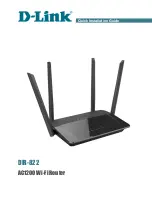
Configuring the Switch
3-246
3
VoIP Traffic Configuration
When IP telephony is deployed in an enterprise network, it is recommended to
isolate the Voice over IP (VoIP) network traffic from other data traffic. Traffic isolation
can provide higher voice quality by preventing excessive packet delays, packet loss,
and jitter. This is best achieved by assigning all VoIP traffic to a single Voice VLAN.
The use of a Voice VLAN has several advantages. It provides security by isolating
the VoIP traffic from other data traffic. End-to-end QoS policies and high priority can
be applied to the VoIP VLAN traffic across the network, guaranteeing the bandwidth
it needs. The VLAN isolation also protects against disruptive broadcast and
multicast traffic that can seriously affect voice quality.
The switch allows you to specify a Voice VLAN for the network and set a CoS priority
for the VoIP traffic. VoIP traffic can be detected on switch ports by using the source
MAC address of packets, or by using LLDP (IEEE 802.1AB) to discover connected
VoIP devices. When VoIP traffic is detected on a configured port, the switch
automatically assigns the port as a tagged member the Voice VLAN. Alternatively,
switch ports can be manually configured.
Configuring VoIP Traffic
To configure the switch for VoIP traffic, first enable the automatic detection of VoIP
devices attached to switch ports, then set the Voice VLAN ID for the network. The
Voice VLAN aging time can also be set to remove a port from the Voice VLAN when
VoIP traffic is no longer received on the port.
Command Attributes
•
Auto Detection Status
– Enables the automatic detection of VoIP traffic on switch
ports. (Default: Disabled)
•
Voice VLAN ID
– Sets the Voice VLAN ID for the network. Only one Voice VLAN
is supported and it must already be created on the switch. (Range: 1-4094)
•
Voice VLAN Aging Time
– The time after which a port is removed from the Voice
VLAN when VoIP traffic is no longer received on the port.
(Range: 5-43200 minutes; Default: 1440 minutes).
Note:
The Voice VLAN ID cannot be modified when the global Auto Detection Status is
enabled.
Summary of Contents for iES4028F
Page 1: ...iES4028F 4028FP 4024GP ...
Page 4: ...iv This page is intentionally left blank ...
Page 10: ...x This page is intentionally left blank ...
Page 28: ...Contents xxviii This page is intentionally left blank ...
Page 32: ...Tables xxxii This page is intentionally left blank ...
Page 46: ...Introduction 1 10 1 This page is intentionally left blank ...
Page 336: ...Configuring the Switch 3 280 3 This page is intentionally left blank ...
Page 688: ...Command Line Interface 4 352 4 This page is intentionally left blank ...
Page 702: ...Glossary Glossary 8 This page is intentionally left blank ...
Page 710: ...Index 8 Index This page is intentionally left blank ...
Page 711: ...This page is intentionally left blank ...
Page 712: ...iES4028F 4028FP 4024GP ...
















































